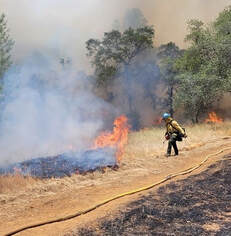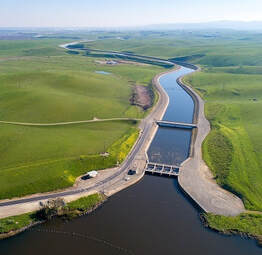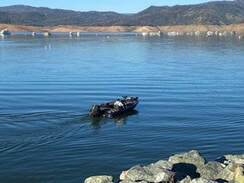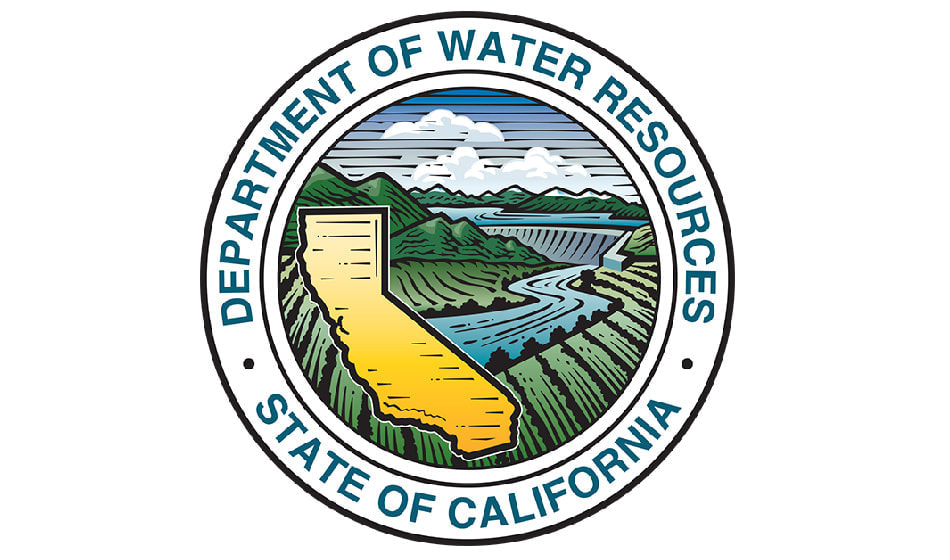 Lake Oroville Boat RampThe Bidwell Canyon Stage III Boat Ramp is now closed due to low lake levels. The Department of Water Resources (DWR) has opened the gravel boat ramp at the Spillway. This ramp may be accessed from the Lakeside Access Road between Oroville Dam and the Spillway Day Use Area and Boat Launch. Four-wheel-drive vehicles are highly recommended – please use at your own risk. The auxiliary ramp is gravel on dirt which becomes slippery when wet, especially during times of heavy usage. To maintain the integrity of the steep ramp, drivers are encouraged to avoid tire spin by engaging vehicles in 4-wheel drive and accelerating slowly when exiting the ramp, with or without a loaded trailer. The Spillway gravel boat ramp is open 24-hours a day. Both the Lime Saddle and Bidwell Canyon marinas remain open from 8 a.m. until sundown with shuttle service and boat rentals available.  FEATHER RIVER FISH HATCHERY Chinook salmon spawning operations have successfully concluded at the Feather River Fish Hatchery. The hatchery collected 9.5 million fall-run, 2.4 million spring-run, and 126,000 inland Lake Oroville Chinook salmon eyed eggs this year. The hatchery’s spawning process collects eggs from female fish and milt (sperm) from male fish to fertilize the eggs. After fertilization, the eggs are placed in incubators to develop and approximately 30-days post fertilization, the healthy eggs develop eyes (eyed egg). After the young salmon further develop in the incubators and reach the “fry” stage, they are transferred to long ponds filled with Feather River water called “raceways” to grow until they are large enough to be returned to the river or planted in locations further downstream to avoid predators. Planting operations for Chinook will occur March through June. The Feather River Fish Hatchery is a California State Water Project (SWP) facility owned and maintained by DWR, which funds hatchery operations. The California Department of Fish and Wildlife (CDFW) operates the hatchery, including fish spawning, rearing, and stocking activities. DWR built the fish hatchery to mitigate the impact of the Oroville Dam on Chinook salmon and steelhead populations because the dam blocks access to natural spawning grounds further upstream.  CONTROL BURN AT LOAFER CREEK CAL FIRE, Butte County Fire Department, Plumas National Forest, DWR and California Department of Parks and Recreation (State Parks) are continuing control burn activities in the Loafer Creek Recreation Area near Lake Oroville. The goal of the control burn is to remove overgrown ladder fuels and dead and dying vegetation and minimize ground fuels to create a more wildfire resistant landscape. Multiple burn areas were planned beginning Thursday, Nov. 17 and possibly continuing through the week of Nov. 21, depending on weather and incident activity in Butte County. Some intermittent trail closures in the Loafer Creek Recreation Area may occur. Trail users are advised to be “safety-aware” and obey posted trail closure signage. Smoke from the activity has been, and may continue to be, visible in the Oroville area. DWR’s Fuel Load Management Plan (FLMP) works to reduce wildfire risk and increase public safety around Lake Oroville. Previous FLMP projects in the Loafer Creek Recreation Area have been identified as contributing to the slowing of the 2020 North Complex Fire as it approached Kelly Ridge, increasing firefighters’ ability to establish a secure fire line and preventing the fire from progressing. Ongoing management of this critical area remains a high priority for the FLMP.  OROVILLE RECREATION Boaters are reminded that power boats are allowed on the Thermalito South Forebay as well as the Thermalito Afterbay. A 5-mph speed limit for all boats is in effect on the Afterbay north of the Highway 162 bridge and near the brood ponds on the east side of the reservoir, with regular boating rules in effect south of the Highway 162 bridge. No motorized boating is allowed in the Thermalito North Forebay. The Monument Hill facility at Thermalito Afterbay provides boat ramp access, restrooms, a picnic area, and beach. The Thermalito South Forebay facility has a two-lane boat ramp, parking, restroom, picnic tables, BBQs, shade trees, and a fish cleaning station. The Lake Oroville Visitor Center is open Tuesday through Thursday, 9 a.m. to 5 p.m. (closed on Thanksgiving Day) and offers visitors numerous educational exhibits, a theater featuring videos about the building of Oroville Dam, walking and hiking trails, and a 47-foot-tall observation tower providing unsurpassed panoramic views of Lake Oroville, the valley, the foothills and Sierra Nevada, and the Sutter Buttes, known as the smallest mountain range in the world. DWR and State Parks maintain over 92 miles of trails in the Oroville area. Trails and their permitted uses (hike, bike, horse, multi), day use areas, boat ramps, and other recreation facilities are featured on DWR’s interactive Lake Oroville Recreation webpage. The Feather River Fish Hatchery is open daily 8 a.m. to 3 p.m. with the Fish Barrier Dam Overlook area and underwater viewing window open sunrise to sunset. CURRENT LAKE OPERATIONS Oroville’s reservoir is about 665 feet elevation and storage is about 1.07 million acre-feet (MAF), which is 28 percent of its total capacity and 57 percent of the historical average. Temperatures are forecasted in the upper-50s to low-to-mid-60s over the weekend and into next week with a slight chance of showers early in the week. The Feather River releases are currently at 1,600 cubic feet per second (cfs) and meet the downstream Delta water quality and outflow needs. Flows through the City of Oroville are 650 cfs with 950 cfs released from the Thermalito Afterbay Outlet (Outlet) for a total of 1,600 cfs downstream of the Outlet. DWR continues to assess releases to the Feather River daily. The public can track precipitation, snow, reservoir levels, and more at the California Data Exchange Center. The Lake Oroville gage station is identified as “ORO”. All data as of midnight 11/17/2022 DWR wishes everyone a Happy Thanksgiving. The Lake Oroville Community Update will return on December 2, 2022.  California is in its third year of drought conditions. With water conservation now a way of life in California, everyone is encouraged to find ways to save water. See tips, tools, and ideas on the Save Our Water website. Information about real time local hydrological conditions, forecasts, and water conditions is available on DWR’s new website California Water Watch.  Water Quality Monitoring Underway The Department of Water Resources (DWR) recently installed water quality monitoring devices called sondes in Lake Oroville and the Thermalito Diversion Pool. Sondes measure the water’s temperature, pH (acidic or basic level of hydrogen), dissolved oxygen (oxygen levels available to aquatic organisms), and turbidity (the clarity of water). Sonde data is collected around the clock every 15 minutes and is analyzed by the Water Quality Section of DWR’s Northern Region office. The monitoring devices are expected to remain in place until the runoff season ends, which is typically around May or June. Routine water quality monitoring occurs on a monthly basis in Lake Oroville including three locations in the forks of the Feather River added to monitor runoff from burn scar areas in the Feather River watershed. In 2020, the multi-agency “Watershed Working Group”, led by the California Governor’s Office of Emergency Services (CalOES), implemented targeted monitoring of rivers, lakes, and other surface waters in the North Complex and Dixie fire burn areas and downstream. The Central Valley Regional Water Quality Control Board (Water Board), the California Department of Fish and Wildlife (CDFW), and DWR collect and test water samples for analysis.  STATE WATER PROJECT CAPABILITY REPORT The DWR released the State Water Project Delivery Capability Report 2021, which is generated every two years for the State Water Project’s (SWP) 29 water agencies for water supply planning. With California entering a possible fourth dry year, the report will help water managers better understand how key factors like climate change and regulatory and operational considerations affect the operation of the SWP under historical and future scenarios. The report includes estimates on the SWP’s water delivery capability for current and future conditions based on three major factors:
DWR OFFERS GRANT PROGRAMS DWR is accepting applications for $510 million in financial assistance to support water supply reliability, yard transformation, and migratory birds as California continues to be impacted by climate change and several years of drought conditions. “California is moving aggressively to transform the way we use and manage water so we can thrive in a hotter, drier future,” said DWR Director Karla Nemeth. “Thanks to the leadership of Governor Newsom and the State Legislature, we are deploying much-needed funding to support communities, farmers, and wildlife as we stretch existing supplies and build climate resilience.” The different grant programs target communities that rely on groundwater, farmers willing to support water conservation in the Delta and aid migratory birds, and an Urban Community Drought Relief Grant Program to help large organizations, water agencies, and communities build resilience, replace thirsty lawns with California native landscaping, and promote water conservation. Information on who is eligible and how to apply before respective deadlines is available on DWR’s News Releases webpage. OROVILLE RECREATION ADVISORY COMMITTEE The Oroville Recreation Advisory Committee met on Nov. 4 at the Southside Community Center in Oroville. ORAC was established by the Federal Energy Regulatory Commission (FERC) to review and provide recommendations regarding DWR’s recreation plan for the Project No. 2100 – Oroville Facilities. The 13-member committee is made up of representatives from state and local government, sports and recreation groups, and business and community organizations. To obtain a summary of the meeting, send a request to [email protected]  OROVILLE RECREATION The Lake Oroville Visitors Center is open Tuesday through Thursday, 9 a.m. to 5 p.m. and offers visitors numerous educational exhibits, a theater featuring videos about the building of Oroville Dam, walking and hiking trails, and a 47-foot-tall observation tower providing unsurpassed panoramic views of Lake Oroville, the valley, the foothills and Sierra Nevada, and the Sutter Buttes, known as the smallest mountain range in the world. DWR and State Parks maintain over 92 miles of trails in the Oroville area, including those around the Lake Oroville Visitor Center. There are paved, accessible trails with only slight elevation changes by the Visitor Center and the North Forebay Day Use Area. Other trails, such as the Brad Freeman Trail between the Spillway Day Use Area and the Diversion Pool, offer steep elevation changes to challenge hikers and mountain bikers. The Saddle Dam Trailhead has facilities for equestrians, including a large parking area to accommodate horse trailers, water trough, and hitching posts, and easy access to trails designated for hikers and horses. Trails and their permitted uses (hike, bike, horse, multi), day use areas, boat ramps, and other recreation facilities are featured on DWR’s interactive map on DWR’s Lake Oroville Recreation webpage at https://water.ca.gov/What-We-Do/Recreation/Lake-Oroville-Recreation. The Bidwell Canyon Stage III boat ramp remains open for boating and for fishing enthusiasts who are finding success at Lake Oroville. The Feather River Fish Hatchery continues to perform spawning, rearing, and stocking activities and is open daily 8 a.m. to 3 p.m. The Fish Barrier Dam Overlook area and underwater viewing window is open sunrise to sunset. CURRENT LAKE OPERATIONS Oroville’s reservoir is about 671 feet elevation and storage is about 1.05 million acre-feet (MAF), which is 30 percent of its total capacity and 59 percent of the historical average. Temperatures are forecasted in the upper-50s to low-to-mid-60s over the weekend and into next week. The Feather River releases are currently at 2,000 cubic feet per second (cfs) and continue to meet downstream Delta water quality and outflow needs. Flows through the City of Oroville are 650 cfs with 1,350 cfs released from the Thermalito Afterbay Outlet (Outlet) for a total of 2,000 cfs downstream of the Outlet. DWR continues to assess releases to the Feather River daily. The public can track precipitation, snow, reservoir levels, and more at the California Data Exchange Center at www.cdec.water.ca.gov. The Lake Oroville gage station is identified as “ORO”. All data as of midnight 11/9/2022  California is in its third year of drought conditions. With water conservation now a way of life in California, everyone is encouraged to find ways to save water. See tips, tools, and ideas on the Save Our Water website. Information about real time local hydrological conditions, forecasts, and water conditions is available on DWR’s new website California Water Watch.  State Water Project Capability Report The Department of Water Resources (DWR) released the State Water Project Delivery Capability Report 2021, which is generated every two years for the State Water Project’s (SWP) 29 water agencies for water supply planning. With California entering a possible fourth dry year, the report will help water managers better understand how key factors like climate change and regulatory and operational considerations affect the operation of the SWP under historical and future scenarios. The report includes estimates on the SWP’s water delivery capability for current and future conditions based on three major factors:
DWR Offers Grant Programs DWR is accepting applications for $510 million in financial assistance to support water supply reliability, yard transformation, and migratory birds as California continues to be impacted by climate change and several years of drought conditions. “California is moving aggressively to transform the way we use and manage water so we can thrive in a hotter, drier future,” said DWR Director Karla Nemeth. “Thanks to the leadership of Governor Newsom and the State Legislature, we are deploying much-needed funding to support communities, farmers, and wildlife as we stretch existing supplies and build climate resilience.” The different grant programs target communities that rely on groundwater, farmers willing to support water conservation in the Delta and aid migratory birds, and an Urban Community Drought Relief Grant Program to help large organizations, water agencies, and communities build resilience, replace thirsty lawns with California native landscaping, and promote water conservation. Information on who is eligible and how to apply before respective deadlines is available on the DWR website’s News Releases webpage. Oroville Recreation Advisory Committee The Oroville Recreation Advisory Committee met today, Nov. 4 at the Southside Community Center in Oroville. ORAC was established by the Federal Energy Regulatory Commission (FERC) to review and provide recommendations regarding DWR’s recreation plan for the Project No. 2100 – Oroville Facilities. The 13-member committee is made up of representatives from state and local government, sports and recreation groups, and business and community organizations. To obtain a summary of the meeting, send a request to [email protected]  CONTROL BURN AT LOAFER CREEK CAL FIRE, Butte County Fire Department, Plumas National Forest, and partners Department of Water Resources (DWR) and California Department of Parks and Recreation (State Parks) have completed control burn activities in the Loafer Creek Recreation Area near Lake Oroville. The control burn removed overgrown ladder fuels and dead and dying vegetation and minimized ground fuels to create a more wildfire resistant landscape. A total of 169 acres were treated. Fuels reduction activities in the Lake Oroville State Recreation Area and in the Oroville-Thermalito Complex’s Federal Energy Regulatory Commission (FERC) boundary are ramping up for the season and will continue through Spring 2023 as weather conditions permit and crews from CAL FIRE, Butte County Sheriff’s Office, and the California Conservation Corps are available. DWR’s Fuel Load Management Plan (FLMP) works to reduce wildfire risk and increase public safety around Lake Oroville. Previous FLMP projects in the Loafer Creek Recreation Area have been identified as contributing to the slowing of the 2020 North Complex Fire as it approached Kelly Ridge, increasing firefighters’ ability to establish a secure fire line, and preventing the fire from progressing. Ongoing management of this critical area remains a high priority for the FLMP.  OROVILLE RECREATION The Loafer Point Stage II boat ramp has closed due to falling lake levels. The Bidwell Canyon Stage III boat ramp remains open for boating and for fishing enthusiasts who are finding success at Lake Oroville. The Feather River Fish Hatchery continues to perform spawning, rearing, and stocking activities and is open daily 8 a.m. to 3 p.m. The Fish Barrier Dam Overlook area and underwater viewing window is open sunrise to sunset. The Lake Oroville Visitors Center is open Tuesday through Thursday, 9 a.m. to 5 p.m. and offers visitors numerous educational exhibits, a theater featuring videos about the building of Oroville Dam, walking and hiking trails, and a 47-foot-tall observation tower providing unsurpassed panoramic views of Lake Oroville, the valley, the foothills and Sierra Nevada, and the Sutter Buttes, known as the smallest mountain range in the world. DWR and State Parks maintain over 92 miles of trails in the Oroville area, including those around the Lake Oroville Visitor Center. There are paved, accessible trails with only slight elevation changes by the Visitor Center and the North Forebay Day Use Area. Other trails, such as the Brad Freeman Trail between the Spillway Day Use Area and the Diversion Pool, offer steep elevation changes to challenge hikers and mountain bikers. The Saddle Dam Trailhead has facilities for equestrians, including a large parking area to accommodate horse trailers, water trough, and hitching posts, and easy access to trails designated for hikers and horses. Trails and their permitted uses (hike, bike, horse, multi), day use areas, boat ramps, and other recreation facilities are featured on DWR’s interactive map on DWR’s Lake Oroville Recreation webpage at https://water.ca.gov/What-We-Do/Recreation/Lake-Oroville-Recreation. CURRENT LAKE OPERATIONS The elevation of Oroville’s reservoir is about 676 feet elevation and storage is about 1.08 million acre-feet (MAF), which is 31 percent of its total capacity and 60 percent of historical average. Cooler temperatures in the low-50s to low-60s are forecast for the weekend with a winter storm arriving Sunday through Tuesday and occasional rain showers expected the rest of the week. The Feather River releases are currently at 2,400 cubic feet per second (cfs) and continue to meet downstream Delta water quality and outflow needs. Flows through the City of Oroville are 650 cfs with 1,750 cfs released from the Thermalito Afterbay Outlet (Outlet) for a total of 2,400 cfs downstream of the Outlet. DWR continues to assess releases to the Feather River daily. The public can track precipitation, snow, reservoir levels, and more at the California Data Exchange Center at www.cdec.water.ca.gov. The Lake Oroville gage station is identified as “ORO”. All data as of midnight 11/3/2022  California is in its third year of drought conditions. With water conservation now a way of life in California, everyone is encouraged to find ways to save water. See tips, tools, and ideas on the Save Our Water website. Information about real time local hydrological conditions, forecasts, and water conditions is available on DWR’s new website California Water Watch.  November 1, 2022 Oroville Recreation Advisory Committee The Oroville Recreation Advisory Committee (ORAC) will meet on Friday, Nov. 4 at 9 a.m. at the Southside Oroville Community Center on 2959 Lower Wyandotte Road in Oroville. Presentations by the state Departments of Water Resources, Parks and Recreation, and Fish and Wildlife, as well as the Oroville Area Chamber of Commerce will be provided. ORAC was established by the Federal Energy Regulatory Commission (FERC) to review and provide recommendations regarding DWR’s recreation plan for the FERC Project No. 2100 Oroville Facilities. The 13-member committee is made up of representatives from state and local government, sports and recreation groups, and business and community organizations. The public is invited to attend.  California is in its third year of drought conditions. With water conservation now a way of life in California, everyone is encouraged to find ways to save water. See tips, tools, and ideas on the Save Our Water website. Information about real time local hydrological conditions, forecasts, and water conditions is available on DWR’s new website California Water Watch. |
Archives
October 2023
Categories
All
|


 RSS Feed
RSS Feed